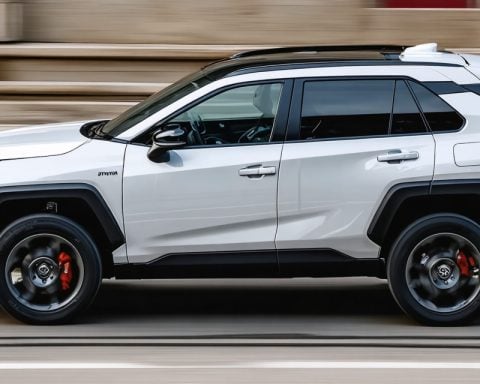U.S. Takes Major Steps Towards Autonomous Vehicle Leadership
On January 7, 2024, the Autonomous Vehicle Industry Association (AVIA) introduced an ambitious policy framework titled, “Securing American Leadership in Autonomous Vehicles.” This initiative calls for immediate federal intervention to solidify the U.S. position in the burgeoning autonomous vehicle (AV) sector, highlighting the importance of safety, innovation, and economic sustainability.
AVIA’s CEO detailed the organization’s commitment to maintaining the U.S. edge in AV technology. He pointed out that while America has made strides in AV safety and efficiency, federal policies are crucial to prevent falling behind rival nations, particularly China, in the global arena of autonomous innovation.
The framework outlines several key recommendations aimed at enhancing safety and operational standards for AVs. One major proposal is the establishment of a comprehensive national safety data repository to improve transparency regarding AV incidents. The organization also advocates for updates to federal safety standards that would better suit Level 4 and 5 autonomous systems.
Further supporting the nation’s supply chain resilience, the AVIA framework encourages legislative measures to facilitate autonomous trucking. This includes reaffirming regulatory interpretations that do not require a human operator in certain commercial vehicles.
As the U.S. gears up for a future dominated by autonomous driving, AVIA’s recommendations offer a strategic pathway to bolster safety, enhance economic growth, and ensure that America remains a leader in this transformative technology.
The Broader Implications of Autonomous Vehicle Policy
The recent push by the Autonomous Vehicle Industry Association (AVIA) underscores a pivotal moment not only for the automotive sector but also for society and the global economy. As the U.S. positions itself as a leader in autonomous vehicle technology, the potential for economic growth is substantial. The autonomous vehicle market is projected to reach over $800 billion by 2035, emphasizing the need for robust policies that encourage innovation while ensuring safety. The development of AVs could lead to new job opportunities in tech, engineering, and logistics, transforming labor markets and reshaping workforce needs.
Culturally, the integration of autonomous vehicles can alter societal perceptions of mobility. With lowered barriers to transportation, such as reduced costs and increased accessibility for elderly and disabled populations, AVs could foster greater social inclusion and redefine urban planning initiatives. Cities may see a decline in traditional vehicle ownership, leading to enhanced public transport systems and reduced traffic congestion.
In terms of environmental impact, autonomous vehicles hold the promise of significant eco-efficiency. Optimized driving patterns facilitated by AI can lead to reduced emissions and lower fuel consumption, potentially playing a role in combating climate change.
As AV technology progresses, future trends will likely include heightened reliance on renewable energy sources powering fleets, and advancements in smart infrastructure that accommodate these vehicles. Long-term, the U.S. could not only lead in technology but also in creating a sustainable model for global automotive and transportation sectors, setting standards that others will emulate.
Driving the Future: How the U.S. Aims to Dominate the Autonomous Vehicle Sector
U.S. Takes Major Steps Towards Autonomous Vehicle Leadership
The race for dominance in autonomous vehicle (AV) technology is intensifying, and the U.S. is positioning itself as a formidable contender. On January 7, 2024, the Autonomous Vehicle Industry Association (AVIA) unveiled a bold policy framework titled “Securing American Leadership in Autonomous Vehicles.” This strategic initiative emphasizes the urgent need for federal engagement to secure the nation’s lead in the rapidly evolving AV sector, focusing on key areas such as safety, innovation, and economic feasibility.
Key Features of the Policy Framework
AVIA’s recommendations include essential improvements aimed at shaping the future of AV technology:
1. National Safety Data Repository: The framework proposes the creation of a centralized database dedicated to accidents and incidents involving AVs. This repository would enhance transparency and facilitate data sharing among stakeholders, helping to refine safety protocols and improve public trust.
2. Updated Federal Safety Standards: Recognizing the unique operational requirements of Level 4 and 5 autonomous vehicles, AVIA calls for a reevaluation of existing federal safety regulations to better accommodate these advanced systems.
3. Support for Autonomous Trucking: With a focus on reaffirming regulations that allow for unmanned operation in commercial vehicles, AVIA seeks to strengthen the supply chain resilience of the U.S. This push could ease the integration of autonomous trucks into the logistics landscape, potentially boosting efficiency and reducing costs.
Pros and Cons of the Autonomous Vehicle Framework
Pros:
– Increased Safety: A comprehensive data repository can lead to better incident analysis, ultimately improving AV safety measures.
– Economic Growth: Supporting autonomous trucking can bolster logistics and create new job opportunities in tech and regulatory oversight.
– Innovation Encouragement: Updating federal standards to match technological advances will foster a more conducive environment for innovation.
Cons:
– Compliance Costs: Companies may face financial burdens adapting to new regulations and standards.
– Job Displacement: Automation in trucking and other sectors may lead to job loss for traditional drivers.
– Regulatory Hurdles: Navigating changes in federal regulations can be complex and slow down innovation if not managed effectively.
Predictions and Trends in Autonomous Vehicles
As the U.S. prepares for an AV-centric future, several trends are anticipated:
– Increased Investment: A surge in both private and public funding for AV technology advancements is expected, especially in AI and machine learning.
– Public-Private Partnerships: Enhanced collaboration between tech companies and government bodies may become a hallmark of future AV developments.
– Adoption of Mixed Fleets: The integration of autonomous and traditional vehicles will likely take place gradually, allowing for a smoother transition.
Implications for the Market
The AV sector is poised for significant growth. Analysts predict that the global autonomous vehicle market could reach $800 billion by 2035. The U.S. must leverage its technological prowess and research capabilities to remain competitive in this burgeoning field.
Conclusion
With the AVIA’s recent framework, the U.S. is taking definitive steps towards ensuring its leadership in the autonomous vehicle arena. By addressing safety standards, supporting logistical advancements, and fostering innovation, America is setting the stage for a revolution in how transport is viewed and utilized. As stakeholders mobilize around this initiative, the potential for economic growth and technological supremacy remains vast.
For more insights on the future of autonomous vehicles, visit AVIA.












